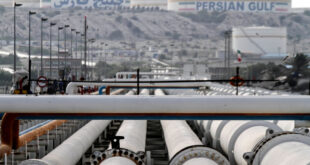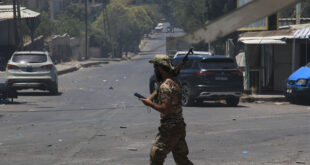The US carried out airstrikes targeting two facilities linked to Iranian-backed militias in eastern Syria on Thursday, according to a statement from Defense Secretary Lloyd Austin, following a series of drone and rocket attacks against US forces in the region.
The US assessed that the airstrikes against the facilities linked to Iran’s Islamic Revolutionary Guard Corps and affiliated groups did not result in any casualties, according to a Friday statement from Brig. Gen. Pat Ryder, the Pentagon press secretary.
The strikes, carried out by an F-15 fighter jet and a pair of F-16 fighter jets using precision-guided munitions, targeted a weapons and ammunition storage facility in Abu Kamal near the border between Syria and Iraq. The strikes destroyed the facilities, according to Ryder.
Austin on Thursday described the strikes, which were ordered by President Joe Biden, as “narrowly tailored in self-defense” and emphasized they are separate from the ongoing conflict in Gaza. He directly accused Iran of having a role in the attacks on US forces, saying in the statement, “Iran wants to hide its hand and deny its role in these attacks against our forces. We will not let them.” Austin also promised further strikes if the attacks by Iran’s proxies continue.
Biden sent a letter to Congress on Friday evening detailing what he called “necessary and proportionate” strikes, writing that they “were intended to establish deterrence and were conducted in a manner to limit the risk of escalation and avoid civilian casualties.”
“I directed the strikes in order to protect and defend our personnel, to degrade and disrupt the ongoing series of attacks against the United States and our partners, and to deter Iran and Iran-backed militia groups from conducting or supporting further attacks on United States personnel and facilities,” Biden wrote.
The two targeted facilities had been previously occupied by members of Iran’s Islamic Revolutionary Guard Corps and affiliated militia groups, a senior military official said. “We know that there were people on the target at various points during the day,” the official said during a briefing with reporters following the attack, emphasizing: “Again, we know that they were not civilians. The people that occupy these locations are Iranian-aligned militia groups as well as IRGC personnel.”
A senior defense official called Iran “the center of gravity” for the attacks on US forces in the region, saying that “Iranian fingerprints are all over this.”
“Tehran and Iranian senior leaders are funding, arming, equipping, training and directing a whole plethora of militia groups across the region, and they have escalated attacks against US forces since October 17, which is why we took self-defense action tonight,” the official said.
The Biden administration has carried out strikes against militias before, but at a time of enormous tension, the US is looking to send a strong message to Iran and the militias not to escalate their attacks and spark a wider conflict in the Middle East. The region is on edge as the Israel-Hamas war, which was triggered by Hamas’ brutal terror attack on October 7, continues.
Earlier Thursday, the US announced it is deploying about 900 troops to the Middle East – with the potential for many more. The US has also moved two carrier strike groups to the eastern Mediterranean Sea and an amphibious ready group closer to Israel in the waters of the Middle East.
The US strikes follow a growing number of attacks against US forces in Iraq and Syria since October 17. As of Thursday evening, when the Syria strikes were announced, US forces had come under attack a total of 19 times, according to the Pentagon, at least 12 separate times in Iraq and four separate times in Syria, resulting in 21 US service members suffering injuries. The Pentagon said the injuries were all minor and that the troops have returned to duty. One US civilian contractor suffered a fatal heart attack as a result of a false alarm at one of the bases in Iraq.
On Friday, the US military shot down a one-way attack drone near Al-Asad Air Base in Iraq, according to a US defense official. It marked the 20th attack and the first since the US announced it had carried out the strikes in Syria.
“At approximately 0700 EDT on 27 October, US forces engaged a one-way attack drone a few kilometers from Al-Assad Air Base, Iraq, and successfully shot it down without further incident,” the official said.
On Wednesday, Biden issued a strong warning to Iran about its proxies attacking US forces in the region. “My warning to the ayatollah was that if they continued to move against those troops, we will respond, and they should be prepared.” Biden also said the presence of US troops in Iraq and Syria is focused on the campaign to defeat ISIS and is not related to the ongoing conflict in Israel.
But Iranian Foreign Minister Hossein Amir-Abdollahian did not attempt to tamp down the tensions Thursday at an emergency session of the UN General Assembly, stating that the US “will not be spared from this fire” if the war in Gaza doesn’t end. Earlier this week, the minister had said that Iran had received two messages from the US, though he would not say how or when the messages were delivered. The first message said the US was not interested in a wider expansion of the conflict, he said, while the second urged Iran and its partners to have self-restraint.
The last known US strike against Iranian-backed militias in the region occurred in March, when the military struck a facility it said was used by groups affiliated with Iran’s Islamic Revolutionary Guard Corps. It followed a similar series of drone and rocket attacks against US facilities in the region.
Ryder, the Pentagon press secretary, said Thursday that the US “will always reserve the right to self-defense” and that if the US chooses to retaliate for the drone and rocket attacks, it would be “at a time and place of our choosing.”
In the face of an increased threat of attack, the Defense Department is rushing additional air defenses to the Middle East. Those systems include a THAAD battery, which is a medium-range air defense system, long-range Patriot batteries, and short-range Avenger air defense systems. The Pentagon declined to say exactly when they would arrive or where they would be stationed.
 Eurasia Press & News
Eurasia Press & News



